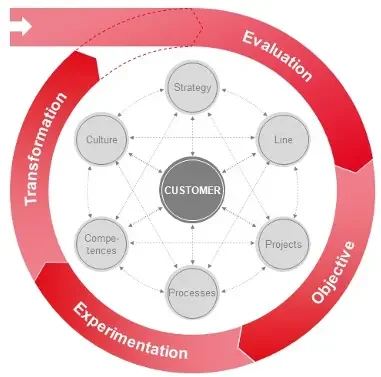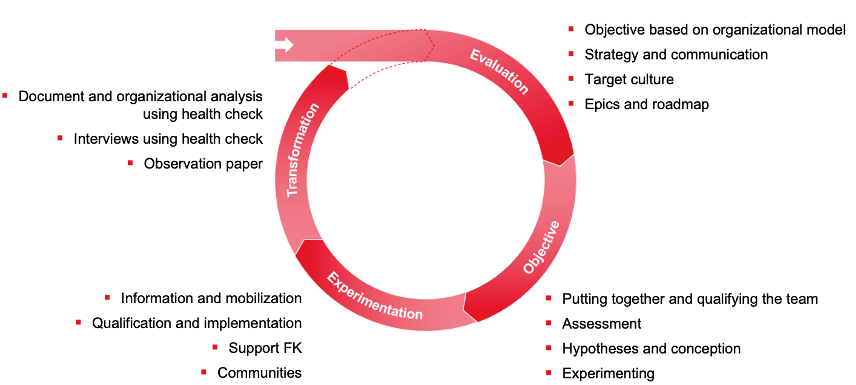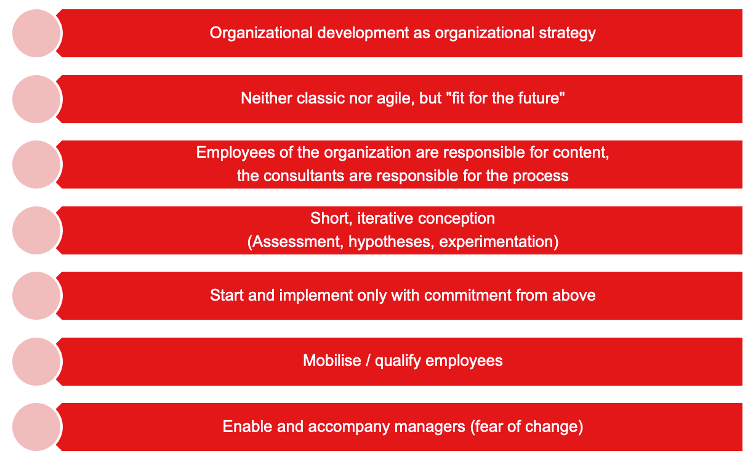Nowadays, there are many different approaches to how to develop organizations agile. The philosophy is that agile working methods and agile organizational structures should always be striven for and ultimately considered to be "better." As for the so-called "agile transition," the same three observations or points as stated by those involved and affected, should always be mentioned again and again:
-
On the one hand, it is noticeable that organizational developments towards pure agility often do not seem to be based on a clear strategic decision. It is often a matter of becoming agile without management thinking about what and why agility should be introduced. Accordingly, most agile transitions seem to follow a textbook rather than the company's real needs and strategic direction.
-
Secondly, employees are (excellently) qualified but sent into new forms of work without orientation, without knowing what this means for them and above all without knowing what is expected of them. Accordingly, many employees react with uncertainty and sometimes with defiance.
-
Finally, it can be observed that even managers tend to struggle with this form of agile transition. Managers also do not know what is expected of them or what leadership in agile organizations can mean.
By agile transformation, we understand a process-like, long-term, continuous organizational development with the goal that organizations can adapt to new conditions, new environmental influences, and new internal and external requirements at any time.
Thus, agile transformation is always organizational and personnel development at the same time. But the one hundred percent radical agility is not necessarily the goal of agile transformation. It is more about enabling organizations to distinguish between change or new development on the one hand and security or stability on the other. Therefore, it is essential to find precisely the right balance between traditional, hybrid, and agile.
And this is exactly the challenge because every organization has different requirements, a different history, different employees, and, of course, different goals. Accordingly, organizations must develop and change; accordingly, they have to decide which form of organization, which structures, and which culture is the best or most suitable in each case.
But the transformation itself should always be agile. Probably, the times when you spent years designing a new organization and implementing it (with great effort), only to realize that it doesn't fit or that events have overtaken you, are finally over.
The 4 Steps of Agile Transformation
An agile transformation proceeds in four steps:
1. Evaluation
The first step is the so-called evaluation, which can certainly be handled optionally in some organizations. Here it is ascertained where the organization or the organizational unit is currently moving in the broad spectrum between traditional and agile. Here it is also possible to develop initial hypotheses on the observations made.
2. Set Objectives
The next step is the objective that the organization sets itself to determine where you want to go and what is necessary to get there. The important thing about this objective is that it consists not only of the strategic decisions of the management but to the same extent also of the ideas and expectations of the employees regarding the culture that this organization should carry.
This objective is developed in workshops with management and executives on issues such as:
- What should remain unchanged?
- What should change?
- What is to be done for it?
Based on this, the management team develops measures for the individual areas of the organizational model described in the previous blog in the form of so-called epics, i.e., a "vision on a high abstraction level" formulated in everyday language. In parallel, employees are involved (in workshops and large group events), and a target culture is formulated and communicated. This target culture is, in turn, aligned with the epics of the management or extends them.
3. Experimentation
In the third step, i.e. experimentation, we follow the almost traditional model with assessment, hypotheses, and experimentation. Teams of experts are assembled and trained, according to Epics. These expert teams now examine the individual aspects of the objective in greater detail, formulate hypotheses, and try them out in prototype/model areas. In other words, the expert teams learn what works, what doesn't work, what is helpful, and what is not. They regularly engage in reviews and retrospectives.
4. Transformation
Everything that has proven successful in experimentation is transferred to other parts of the organization or the entire organization in the final step, the transformation. In addition to the necessary structural implementation, however, the focus should always be on information and mobilization as well as the qualification of employees. In the medium and long term, managers need to be accompanied in the change and their new roles, and communities need to be established in which employees support each other in a self-organized manner.
Principles of Agile Transformation
Agile transformations are based on clear principles that have emerged from our many years of experience in organizational development and are intended to provide orientation and frameworks for all participants:
-
Organizational development must be organizational strategy.
This means that the management must have a strategy for both where it wants to go with the organization and how to achieve its objective. -
Neither traditional nor agile, but "fit for the future."
It is not a matter of dogmatically introducing a theoretical organizational model but of developing the organization so that it is able to work according to the changed conditions. -
Employees of the organization are responsible for the content; the consultants are responsible for processes.
As a consultant, you can help an organization develop in the way it wants; you can and should also bring in your expertise to eliminate blind spots in the customer's organization, but the responsibility for content always remains with the customer. -
Short, iterative conception.
The agile approaches to organizational development and process optimization are applied here. Trying, learning, and then implementing, only to learn again ... This seems to be the most successful approach. -
Start and implement only with commitment from above.
The transformation of what has been evaluated successfully in experimentation always requires the consent of management. Even if this may seem difficult at first, it is necessary for the transformation to be successful. -
Mobilize and qualify employees.
For employees, organizational developments always mean a significant change. However, this known fact becomes all the more critical as the employees create more new forms of organizations. Therefore, employees must be qualified even more than usual for what they are supposed to do in the future. -
Empower and accompany managers (fear of change).
Without leaders living the agile transformation, it will not work. In particular, employees will always orient themselves to their managers what makes it necessary for managers to be accompanied over a relatively long period in the implementation of the transformation.
Conclusio
Whatever your company’s operational context looks like, there will be no organizational stability in the long run. Therefore, the goal must be to enable organizations to adapt to new conditions, new environmental influences, and new internal and external requirements at any time. Even if there is no guarantee of success, there is no doubt that agile transformation based on a sound understanding of the organization helps achieve this goal.







 Jira
Jira
 Confluence
Confluence
 SAP
SAP
 API
API






